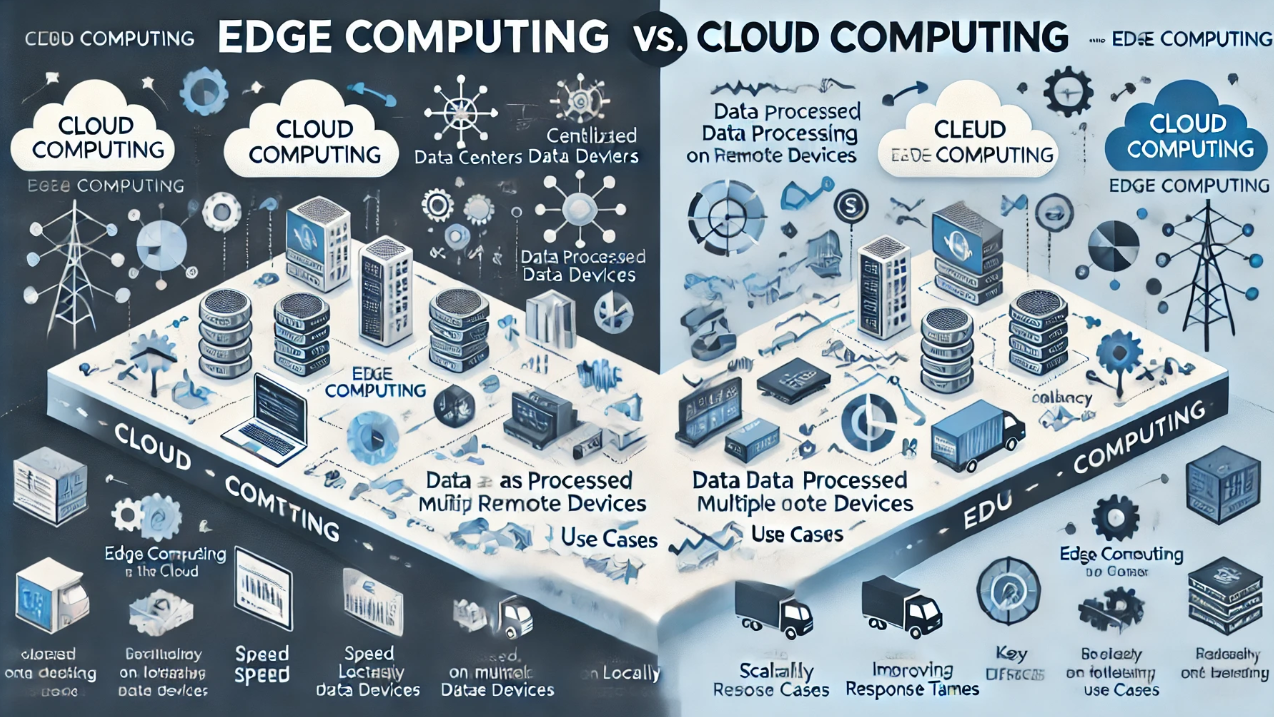The Rise of Edge Computing: How It’s Changing Data Processing
Introduction
As the demand for real-time data processing increases, edge computing is revolutionizing the way businesses handle and process data. Instead of sending all data to the cloud, edge computing processes data closer to the source, reducing latency, bandwidth usage, and security risks.
Did you know? The edge computing market is projected to reach $111 billion by 2028, with industries like IoT, healthcare, and manufacturing leading the way!
What This Guide Covers:
✅ What is edge computing and why is it growing?
✅ Key benefits compared to cloud computing
✅ Industries adopting edge computing
✅ The future of edge computing in AI and IoT
By the end, you’ll understand how edge computing is reshaping data processing across multiple industries.
1. What is Edge Computing?
️ Definition
Edge computing is a decentralized IT architecture that processes data closer to where it is generated—at the “edge” of the network—rather than relying solely on cloud-based data centers.
How It Works:
✔️ Data is collected from sensors, IoT devices, or local servers.
✔️ Edge devices analyze and process data locally instead of sending everything to a cloud.
✔️ Only critical or summarized data is sent to cloud servers for further processing.
✅ Result? Faster, more efficient, and cost-effective data processing!
2. Why is Edge Computing Growing So Fast?
Key Benefits of Edge Computing
| Feature | Edge Computing | Cloud Computing |
|---|---|---|
| Latency | Ultra-low (near real-time) | Higher latency (dependent on network speed) |
| Bandwidth Usage | Lower (processes data locally) | High (data is constantly uploaded to the cloud) |
| Security & Privacy | Stronger (data stays on-site) | More vulnerable (data is transferred over the internet) |
| Reliability | Works even if network is down | Dependent on cloud availability |
Why It’s Growing Rapidly:
✔️ The rise of IoT devices generating massive amounts of data.
✔️ 5G networks enabling faster connectivity for edge computing.
✔️ Businesses demanding real-time processing for AI-driven applications.
✅ Result? Edge computing is faster, more secure, and cost-effective compared to cloud-based processing!
3. Industries Driving the Growth of Edge Computing
Healthcare: Real-Time Patient Monitoring
Hospitals & healthcare providers use edge computing for:
✔️ Remote patient monitoring – IoT health devices analyze vital signs locally.
✔️ AI-powered diagnostics – MRI scans processed on-site instead of cloud-based AI.
✔️ Surgical robotics – Low-latency edge computing enables precise, real-time AI-assisted surgeries.
Example: Philips’ IntelliVue Guardian System processes patient vitals in real-time at the hospital edge, reducing emergency response time.
Manufacturing: Smart Factories & Automation
Manufacturing plants use edge computing for:
✔️ Predictive maintenance – AI models analyze machine data to prevent failures.
✔️ Automated quality control – Cameras and sensors detect defects instantly.
✔️ Robotics & automation – Edge AI optimizes production lines in real time.
Example: Siemens’ Industrial Edge Platform enables on-site AI analytics for manufacturing efficiency.
Automotive: Autonomous Vehicles & Smart Traffic Systems
✔️ Self-driving cars – Process sensor data locally for real-time decision-making.
✔️ Connected vehicles – Edge computing reduces lag in vehicle-to-vehicle (V2V) communication.
✔️ Traffic management – AI-powered traffic systems optimize signals & reduce congestion.
Example: Tesla’s Autopilot AI processes data on-device, reducing the need for cloud connectivity.
Retail: Smart Stores & Personalized Shopping
✔️ Checkout-free shopping – AI-powered cameras detect purchases in real time.
✔️ Customer behavior tracking – Analyzes store traffic & optimizes layouts.
✔️ Supply chain optimization – Real-time tracking of inventory & logistics.
Example: Amazon Go stores use edge AI cameras to detect when customers pick up items—no cashiers needed!
4. The Future of Edge Computing: AI, 5G, and Beyond
AI-Powered Edge Computing
✔️ AI models deployed on edge devices enable real-time decision-making.
✔️ Reduces the need for constant cloud connectivity.
Example: NVIDIA’s Jetson AI platform runs machine learning models on edge devices, powering smart robots & autonomous systems.
5G & Edge Computing: A Game-Changer
✔️ 5G’s ultra-low latency enhances edge computing.
✔️ Enables faster AI-powered processing for self-driving cars & smart cities.
Example: Verizon uses 5G edge computing to power augmented reality (AR) applications.
Final Thoughts: Why Edge Computing is the Future
For IoT & Smart Devices: Provides real-time processing without cloud delays.
For Businesses: Reduces bandwidth costs and improves data security.
For AI & Automation: Enables faster, more efficient decision-making.
Final Recommendation:
✅ Adopt edge computing if your business requires real-time processing & low-latency AI.
✅ Invest in 5G-enabled infrastructure for next-gen applications.
✅ Combine edge computing with cloud AI for the best of both worlds!
Edge computing is revolutionizing industries—are you ready to leverage its power?
Would you like a step-by-step guide on implementing edge computing in your business? Let me know!

